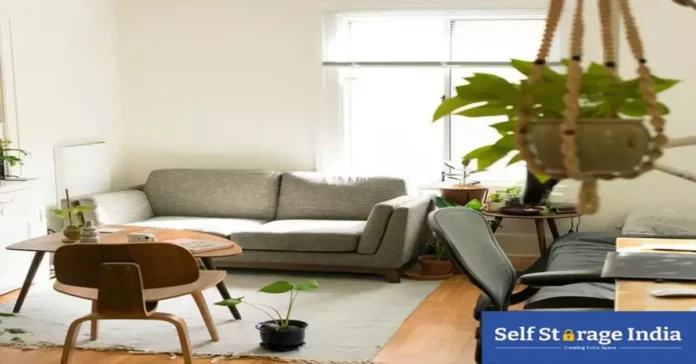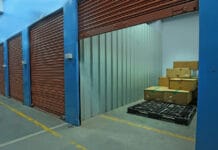Adding personal touches to your workspace can make it unique and inspiring. Start by decluttering your desk and removing unnecessary items. This creates space for personal decor. Use box storage to keep supplies organized and tidy. Incorporate items that reflect your personality, like photos or plants. These small touches can brighten your day.
During the renovation, consider new storage options. Shelves and cabinets can help keep your workspace neat. Use document storage solutions to keep important papers organized. This reduces clutter and makes it easier to find what you need.
Personalize your space with art or inspirational quotes. Choose colours that motivate you and make you feel comfortable. A well-organized and decorated workspace can boost productivity and creativity. By decluttering and adding personal touches, you create an efficient and inspiring environment. This helps you stay focused and enjoy your work more.
Home Decluttering Tips
Decluttering your home can transform your space and enhance productivity. Start by sorting items into categories: keep, donate, and discard. Box storage is used for seasonal items and rarely used belongings. Optimize your storage options by investing in shelves, cabinets, and utility lockers to keep everything organized. Tackle one room at a time to avoid feeling overwhelmed. Incorporate document storage solutions to keep important papers in order. This creates a cleaner environment, reduces stress, and makes your home more efficient. A well-organized home fosters a sense of calm and allows you to enjoy your space more fully.
1. Create an Inventory
Take an inventory of your home’s contents before you begin any significant decluttering projects. Include every piece of furniture, piece of art, trinket, book, item of clothing, etc. in this. What you discover may surprise you.
2. Browse Every Room
Begin in the areas where you spend the most time. Principles of minimalism teach us to examine every object in each room to determine which ones you really need. After that, store them or donate them.
3. Have a Plan
Before you start, plan. Select the items you want to keep, sell, donate, or throw away. Determine whether there are any locations you would like to store objects. It is a lot easier to declutter when you have a visual representation of where you need to get started.
4. Start Small
If you are new to decluttering, you can slowly build momentum with just five minutes a day. When decluttering, start small. Choose a room or one part of your home, like your kitchen counter, and take a photo of a small area. Quickly clean off the items in the photo and take an after photo. Once you see how your home could look, it becomes easier to keep yourself motivated and declutter more of your home.
5. Seek Assistance
Having someone clear up your clutter might be quite beneficial. Find out if your friends, relatives, roommates, co-workers, and neighbours are eager to lend a hand. It may even be wise to hire professional help in decluttering your home, cleaning your closest and making your living space more comfortable.
6. Set Up Storage
Once you have determined what you want to preserve and what you do not, set up storage systems and a location to keep them. Use your garage, walls, shelves, baskets, bins, and boxes. Be on the lookout for furniture that also convert into storage pieces, these items can save space and help you put away decorative/seasonal items.
7. Clear Out Every Space
After you have chosen a location to store everything, clean out every available space. Discard outdated books, magazines, clothes, toys, and other items. Sort them out into different piles such as Donate-Throwaway-Keep, once you have identified which items fall under each of those piles, you can begin clearing them away.
8. Maintain Order – Home Decluttering Tips
Group comparable goods together in storage. Keep your paper towels, cleaning supplies, and other items organised, for instance. Acrylic storage containers are among the strongest and most adaptable storage solutions for every room in the house. They also stack to maximise storage space and are available in a wide range of sizes. They can be used for accessories, shoes, or sweaters in any room of the house, including the closet, pantry, laundry room, and refrigerator.
9. Donate Items – Home Decluttering Tips
After you have finished giving or discarding stuff, let others know. Inform your loved ones, close friends, neighbours, and co-workers. They might find it useful to know they can borrow from you in the future. A lot of charities will take donations of second-hand goods. Examples include Goonj and Red Cross.
10. Be realistic – Home Decluttering Tips
Giving stuff away is not always simple. Asking yourself these questions can help you determine whether anything belongs there or not. Is it beneficial? Does it make me happy? Will I utilise it once more?
11. Sell Unwanted Items
It is simple to put off fixing items, like that watch that needs a new band or that pair of clothes that need to be hemmed, in the hope that you will find the time to do so eventually. If you do not get to it within 30 days, it is time to let them go. Check your local Facebook Marketplace, eBay, Craigslist, yard sales, and classified advertising.
12. Store Extra Clothing
Only put on what fits properly, and after wearing additional clothing, hang it up to dry. Peek at your closet to see if there are any items that do not fit or look decent. Then arrange the clothing according to brand, season, size, style, and colour.
13. Reduce-Reuse-Recycle Old Items
For optimum usage of your items and not buying the latest items until the old ones are gone from your home, we recommend you use the 3 Rs of waste management – Reduce, Reuse, Recycle.
- Reduce means to reduce the amount of waste we produce.
- Reusing means finding new uses for items that would otherwise be discarded.
- Recycling is the process of converting something old and useless (such as plastic milk jugs) into something new and useful stationary holders etc.
Rather than buying latest items, consider reusing old ones. Think about recycling old items like rugs, t-shirts, plastic bags, and cardboard boxes. Recycling is one of the best ways to reduce waste and save money; find recycling facilities near you. This is a simple action you can take. Use reusable bags when shopping, store leftovers in containers, and recycle bottles and cans.
14. Consider Purchasing Used Goods
Purchasing used goods might occasionally be more cost-effective than purchasing brand-new goods. But make sure you invest in durable, high-quality goods.
15. Purchase Fewer Goods
Purchasing less stuff reduces the amount of clutter in your home. Additionally, rather than searching through mountains of pointless goods, you will have more time to spend with your loved ones.
The objective is to take your first step toward decluttering your life with joy, regardless of the decluttering tip you select to get started – whether you want to start off at step one or at step fifteen of these tips, there is always a way to declutter your home.
Final Words for Home Decluttering Tips
In conclusion, implementing home decluttering tips can transform your living space into a more productive and efficient environment. By regularly sorting and organizing your belongings, you can reduce stress and enhance your daily routine. Utilize storage options like utility storage and document storage to keep items in order and easily accessible. Personalize your space during renovations to reflect your style and create a comfortable atmosphere. Decluttering not only improves the aesthetics of your home but also boosts your overall well-being. Embrace these tips to enjoy a clutter-free, organized, and inspiring living space.
FAQs on Home Decluttering Tips
A1: Decluttering reduces stress, creates more space, and makes your home more organized and enjoyable.
A2: To make the task manageable, start by cleaning one room or area at a time, like your closet or kitchen.
A3: Ask yourself if you use the item regularly or if it brings you joy. If not, consider discarding or donating it.
A4: Box storage, shelves, and cabinets should be used to keep items organized and out of sight.
A5: Break the task into small steps and set aside a specific daily time to declutter.
A6: Donate, sell, or recycle items that are still in good condition. Discard anything that’s broken or unusable.
A7: Regularly, such as once a month or seasonally, to keep clutter from accumulating.
A8: Yes, a clean and organized space can help you focus better and be more productive.
A9: Develop daily habits like putting things away immediately and not accumulating unnecessary items.
A10: Yes, use storage bins, labels, and organizational apps to help keep track of your belongings and stay organized.







